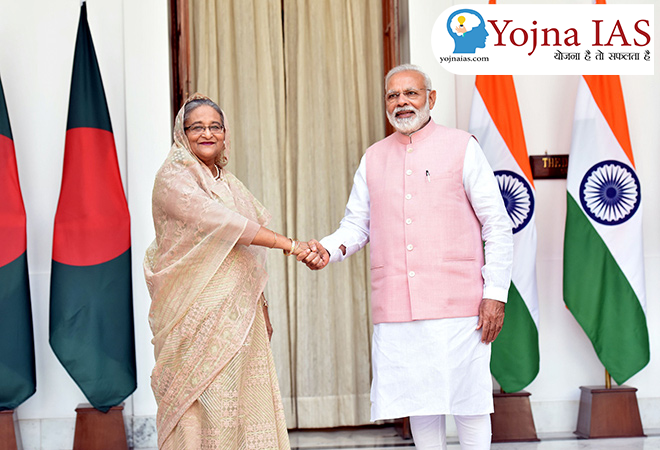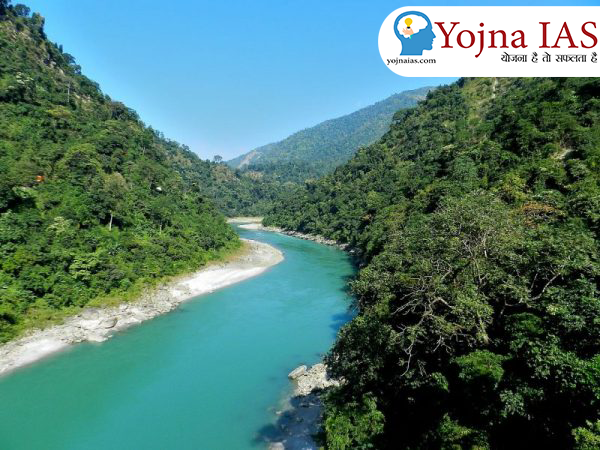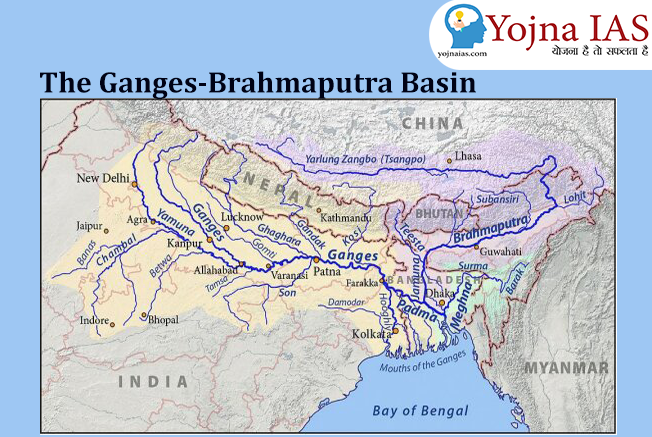11 Jan 2024 India – Bangladesh Relations in the Current Geopolitical Perspective: Opportunities and Challenges.
Source – The Hindu and PIB
General Studies – International Relations, India – Bangladesh Relations South Asian Association for Regional Cooperation, Indian Ocean Rim Association, Rohingya Refugees, One Belt One Road Initiative, Mission Insaniyat.
Why in the News ?
- In the general elections held in India’s neighboring country Bangladesh in the month of January 2024, Bangladesh Prime Minister Sheikh Hasina’s party ‘Awami League‘ got a big victory. Out of 299 seats, Awami League has won 222 seats. The other big political party ‘Jatiya Party’ got only 11 seats. Independent candidates have won 65 seats. In Bangladesh, any party/parties with majority need 151 seats to form the government.
- 14 candidates from the minority community have won the elections, out of which 12 candidates are from the Hindu community. It is noteworthy that Hindu community in Bangladesh comes under the category of ‘minority religion/community’. The main opposition party ‘Bangladesh Nationalist Party (BNP)’, which stayed away from this general election, has rejected this election victory and demanded re-voting/election.
- A day after securing a massive majority in the general elections, Prime Minister Sheikh Hasina on Monday said – ‘India is a ‘close friend’ of Bangladesh and both the neighbors have resolved many problems bilaterally.’
- The ‘Awami League Party’ led by Prime Minister Sheikh Hasina has won the general elections for the fourth consecutive time.
- India played a great role in the emergence and rise of Bangladesh as an independent country during the Bangladesh Liberation War in 1971 AD. India was the first country to recognize Bangladesh as a separate and independent country.
- Bangladesh Liberation Day, 16 December, is celebrated as “Victory Day” in India.
- The unique bonds of India-Bangladesh relations have been created by their mutual shared sacrifices.
- The Prime Minister of India recently called the current state of India–Bangladesh bilateral relations a ‘Sonali Adhyay’ (golden phase).

Parliament of Bangladesh :
- There is a parliament in Bangladesh which is called ‘Jatiya Sansad’ or “House of the Nation”. There are 350 members in this Parliament. Out of these 350 members, 300 members are elected through voting while 50 seats are reserved for women on the basis of vote share. To form the government in Bangladesh, any political party is required to win 151 seats and parliamentary elections are held here every five years.
History of Bangladesh :
- Before 1947, Bangladesh was a part of India. At that time Bangladesh was called ‘East Bengal’. Eight years after the partition of India and Pakistan, i.e. in the year 1955, the name of East Bengal was changed to ‘East Pakistan’. After the war between India and Pakistan in 1971, ‘East Pakistan’ became an independent country called ‘Bangladesh’. At that time, the power of Bangladesh came into the hands of ‘Awami League Party’ and Sheikh Mujibur Rahman became the first President and then Prime Minister of Bangladesh. He is also called the ‘Founder of Bangladesh’. Sheikh Mujibur Rahman was the Prime Minister of Bangladesh from 17 April 1971 to 15 August 1975, but he was later assassinated. After the assassination of Sheikh Mujibur Rahman, the reins of ‘Awami League Party‘ was taken over by his daughter Sheikh Hasina. In the year 1981, Sheikh Hasina was elected the leader of ‘Awami League Party’. He served as the Prime Minister of Bangladesh twice, from 1996 to 2000 and from 2008 to 2013. Sheikh Hasina was serving as the Prime Minister of Bangladesh even at the time when the opposition party had boycotted the elections in 2014. After independence from Pakistan in 1971, 12 general elections have been held in Bangladesh so far.
Border issues with India and Bangladesh :
- India-Bangladesh relations are rooted in tradition, culture, language and mutual values such as secularism, democracy and other commonalities. From 1947 to 1971 AD. Till then Bangladesh was a part of Pakistan. It was formed from the ‘divided areas of Bengal and Assam’ of British India. The people of this region started protesting against the dominance, dominance and imposition of Urdu language by West Pakistan. He started protesting against the unfair treatment of Bengali culture and language in contemporary world politics. The citizens there also demanded their equal representation in the government and their fair share of political power. It is noteworthy that Sheikh Mujibur Rahman led the popular resistance to West Pakistani domination.
Importance of Bangladesh for India :
- From the current ‘geopolitical point of view’, ‘Bangladesh’ is extremely important for India in many ways. Negligence in bilateral relations with Bangladesh will prove detrimental to India’s national interests. Bangladesh has the longest land border with India, extending for approximately 4,096 kilometers. Additionally, Bangladesh shares its borders with the Indian states of Assam, Mizoram, Meghalaya, Tripura and West Bengal. There is also a maritime border located between these two countries. Bangladesh is also working on many important projects with India.
- Bangladesh’s geographical location also plays an essential role in the Indian Ocean Region (IOR). The Bangladesh Navy plays a vital role in ensuring that maritime channels of communication remain free from pirates and other threats to maritime trade.
- Bangladesh is also the gateway (entry point) to the north-eastern states of India. Such important initiatives will help in the socio-economic development of the North-Eastern region of India. Bangladesh is important for India for many reasons.
- Geopolitical : Bangladesh neighbors India and shares a long land, river and maritime border. This makes it important for India’s security and foreign policy. For example, India needs cooperation from Bangladesh to counter the Chinese ‘String of Pearls’.
- Economic : India-Bangladesh have close economic relations. India is one of the largest trading partners of Bangladesh. For example, bilateral trade in 2021-2022 was US$18.2 billion.
- Cultural : India and Bangladesh have a shared history, culture and heritage. The people of the two countries are linked by strong cultural and family ties and Bangladesh has a large population of people of Indian origin.
- Strategic: Bangladesh is located at the intersection of South Asia and Southeast Asia and is important for India’s Act East policy, which aims to build closer ties with countries in Southeast Asia.
- Environmental Concerns : Bangladesh and India share cross-border rivers and ecosystems, making it important for both countries to cooperate on issues such as water management and flood control. For example, conservation of the Sundarbans requires coordinated efforts.
Challenges in India-Bangladesh relations in the current geopolitical context :
At present there are following obstacles and challenges between India and Bangladesh –
China Factor of Bangladesh :
- China is increasing its investment in the sectors of infrastructure development, energy and telecommunications in Bangladesh. For example – China is increasing its investment in the construction of BRI and Chittagong port. More than 25 energy projects, including Bangladesh’s second nuclear power plant and the Bangabandhu communications satellite, are being funded by China. Several port development projects are underway. China’s ‘One Belt One Road Initiative‘ has also entangled Bangladesh, and China’s proximity is becoming a cause of security concerns for India.
Problem of Rohingya refugees :
- Bangladesh is home to approximately 11 million Rohingya Muslims. The disaster in Myanmar has prompted the departure and migration of its citizens. India has cordial relations with Myanmar and Bangladesh and does not want to jeopardize mutual relations in such a situation. Apart from carrying out ‘Mission Insaniyat’ as a humanitarian aid operation, India has no direct involvement in resolving this conflict. As a result, there has been a significant divergence in bilateral relations with Bangladesh. As a result, there has been a significant difference in the bilateral relations between India and Bangladesh.
Illegal infiltration and security in border areas :
- The Border Security Force (BSF) has recently targeted and killed smugglers and illegal immigrants from Bangladesh. In Bangladesh, this sparked public outrage and the ‘Bangladesh Rifles’ shot Indian Army members attached to the BSF in provocation. Many defense experts have linked this current incident to religious indoctrination or religious fanaticism of the Bangladesh Army under the influence of the hardline religious organization ISI.
Teesta River dispute between India and Bangladesh :

- In the year 2011, an agreement was made between the two countries under mutual agreement to keep the water flow of the river to minimum. According to that agreement, India will get 42.5% water, Bangladesh will get 37.5% and the remaining 20% water flow of the river will be free. Was given the right to do. Due to some disagreements, this agreement has not been implemented yet.
- The Teesta River is a tributary of the Ganga River and begins in Sikkim before passing through Bengal and Bangladesh. India has 55 percent share in the river water.
- Bangladesh wants more water from India than what it already receives.
- The fourth largest cross-border river of Bangladesh is the Teesta River.
- In Bangladesh, the Teesta floodplain covers an area of 2,750 square kilometers for irrigation and fishing.
- 83 percent of this river’s watershed – the land area where water is stored – is in India, while 17 percent is in Bangladesh.
- Another important subject of conflict in the Teesta river dispute is hydropower.
- There are at least 26 projects operating on this river, most of which are located in the Indian state of Sikkim. The Teesta river water dispute between the two countries is an important reason for wreaking havoc on mutual partnership.
Geopolitical Challenges :
- India–Bangladesh relations have generally been cordial, but have also involved some geopolitical challenges, such as border disputes. There is a long-running dispute between India and Bangladesh over the demarcation of the common border, especially in the areas of Assam and Tripura.
Illegal Immigration :
- Residents of Indian states bordering Bangladesh have faced substantial socio-economic-political challenges as a result of the significant influx of migrants. Due to illegal migration and unblocked flow of migrants across the Bangladeshi border into India has made the mutual relations between the two countries more strained.
Lack of basic infrastructure :
- Inadequate basic infrastructure and connectivity is hindering the growth of economic relations between the two countries. As a result, border tension between Bangladesh and India is not a new thing. A 4,096 km long land border and 180 km long sea border separate India from Bangladesh. The Comilla-Tripura land border, which extends for 6.5 kilometers, has not been demarcated, leaving the border dispute unresolved and connectivity challenges still persist between the two countries.
Challenges arising in the economic sector :
- Non-tariff barriers between India and Bangladesh: Both India and Bangladesh face non-tariff barriers to each other, such as lengthy customs procedures and bureaucratic red tape, which have hindered trade between the two countries. This has created hindrances, which need to be rectified and rationalized very soon.
Security Challenges :
- Terrorism: India has accused Bangladesh-based terrorist groups of carrying out attacks in India and called on Bangladesh to provide greater cooperation to India in combating terrorism.
- Insurgency: According to defense expert sources, the United Liberation Front of Assam (ULFA), National Democratic Front of Bodoland and National Liberation Front of Tripura all run camps in Bangladesh.
- India also has strong evidence that ULFA has several successful income-generating ventures in Bangladesh which it continues to use to finance its militant/insurgent operations in India.
Energy Challenges :
Farakka Barrage controversy :

- Diversion of water from Ganga to Hooghly river has been a major cause of concern raised by Bangladesh several times in the past and both the countries should find an immediate solution between themselves.
- Tension still persists between India and Bangladesh over the distribution of water of Brahmaputra and Ganga rivers.
Conclusion / Path to solution :
The current unresolved and disputed issues between India-Bangladesh relations can be resolved through the following means –
- Resolving the Teesta River water dispute among themselves : Both India and Bangladesh should mutually establish a consensus towards demarcating the boundary of Teesta River water sharing between themselves and reach a mutual agreement in a time bound manner.
- Moving towards establishing better connectivity : There is a strong need for both India and Bangladesh to enhance their maritime or coastal connectivity, roadways, railways and inland waterways by further strengthening cooperation and enhancing a strong and sustainable communication and sustainable pathways. .
- Energy Security : As the global energy crisis is increasing all over the world, it is important that India and Bangladesh cooperate in using clean and green energy to make South Asia self-reliant in the energy sector.
- India-Bangladesh Friendship Pipeline : which will help carry high-speed diesel from India to northern Bangladesh, needs to be further strengthened.
- Focusing towards Comprehensive Economic Partnership Agreement (CEPA) negotiations : Focusing towards India-Bangladesh Comprehensive Economic Partnership Agreement (CEPA) negotiations which started in 2018, the mutual economic relations between India and Bangladesh will have to be further strengthened so that in future Economic relations between the two countries will become stronger.
- Countering China : Assisting Bangladesh with critical technologies and financial assistance will further strengthen India’s ties and will go a long way in helping India counter China’s influence.
- Dealing with the refugee crisis : India and Bangladesh can encourage other countries of the South Asian Association for Regional Cooperation (SAARC) to develop a SAARC Declaration on Refugees, laying down a specific procedure to determine the status of refugees and economic migrants. be announced.
- At present there is a lot of scope for improvement in bilateral relations between India and Bangladesh. Collaboration and integration should be the foundation of connection. Peace is the most important condition for progress. As a result, there is a need for competent border management to provide a peaceful, secure and crime free border.
- Bangladesh’s textile industry is its strength, which helps it maintain its competitive edge.
- Due to India’s large domestic market, India’s inclination towards any country will be significant, which will benefit the exporting country.
- India must balance its priorities and provide strategic support to a friendly nation’s industry.
Practice Questions for Preliminary Exam:
Q.1. Consider the following statements in the context of India-Bangladesh relations in the current geopolitical context.
- The name of Bangladesh Prime Minister Sheikh Hasina’s party is ‘Awami League’ which has won 222 seats in the 2024 general elections.
- Bangladesh Liberation Day, 16 December, is celebrated as “Victory Day” in India.
- Sheikh Mujibur Rahman is also called the ‘Founder of Bangladesh’.
- The Prime Minister of India recently called the current state of India–Bangladesh bilateral relations a ‘Sonali Adhyay’ (golden phase).
Which of the above statement / statements is correct?
(A)Only 1, 2 and 3
(B) Only 2, 3 and 4
(C ) None of these.
(D) All of these.
Answer – (D)
Practice Questions for Main Exam:
Q.1. Explain the economic, political, cultural and strategic relations between India and Bangladesh in the context of regional stability by discussing the various dimensions of India-Bangladesh relations in the current geo-political context.
Qualified Preliminary and Main Examination ( Written ) and Shortlisted for Personality Test (INTERVIEW) three times Of UPSC CIVIL SERVICES EXAMINATION in the year of 2017, 2018 and 2020. Shortlisted for Personality Test (INTERVIEW) of 64th and 67th BPSC CIVIL SERVICES EXAMINATION.
M. A M. Phil and Ph. D From (SLL & CS) JAWAHARLAL NEHRU UNIVERSITY, NEW DELHI.


No Comments